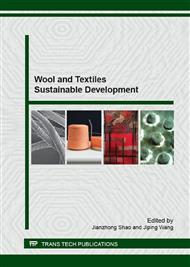[1]
S.F. Liu, Z.Y. Gu, Preparation and Characterization of Temperature-Sensitive Hydrogels Composites by Coating Method, J. Journal of Donghua University (Eng. Ed. ). 27(2010) 469-476.
Google Scholar
[2]
J.L. Hu, S.J. Chen A review of actively moving polymers in textile applications, J. Journal of Materials Chemistry. 20. 17 (2010)3346-3355.
DOI: 10.1039/b922872a
Google Scholar
[3]
W.K. Fong, T. Hanley , B.J. Boyd , Stimuli responsive liquid crystals provide on-demand, drug delivery in vitro and in vivo, J. Journal of Controlled Release. 135 (2009) 218-226.
DOI: 10.1016/j.jconrel.2009.01.009
Google Scholar
[4]
J.R. Lopes, G. Santos, P. Barata, Physical and chemical stimuli-responsive drug delivery systems: targeted delivery and main routes of administration, J. Current pharmaceutical design. 19(2013) 7169-7184.
DOI: 10.2174/13816128113199990698
Google Scholar
[5]
Z.X. Zheng, et al, A novel thermo-responsive drug delivery system with positive controlled release, J. International Journal of Pharmaceutics. 235. 1 (2002) 43-50.
DOI: 10.1016/s0378-5173(01)00976-0
Google Scholar
[6]
B. Liu, J. Hu, Q. Meng. Nonwoven supported temperature-sensitive poly (N-isopropy lacrylamide)/ polyurethane copolymer hydrogel with antibacterial activity, J. Journal of Biomedical Materials Research Part B: Applied Biomaterials. 89 (2009) 1-8.
DOI: 10.1002/jbm.b.31180
Google Scholar
[7]
Prabaharan, Mani, J. F. Mano, Stimuli-Responsive Hydrogels Based on Polysaccharides Incorporated with Thermo-Responsive Polymers as Novel Biomaterials, J. Macromolecular Bioscience. 6. 12 (2006) 991-1008.
DOI: 10.1002/mabi.200600164
Google Scholar
[8]
B.H. Liu, J.L. Hu, The application of temperature-sensitive hydrogels to textiles: A review of Chinese and Japanese investigations, J. Fibres & Textiles in Eastern Europe. 13. 6 (2005) 45-49.
Google Scholar
[9]
D. Crespy, R.M. Rossi, Temperature-responsive polymers with LCST in the physiological range and their applications in textiles, J. Polymer International. 56 (2007) 1461-1468.
DOI: 10.1002/pi.2277
Google Scholar
[10]
Weaver, S. P. Armes, V. Butun. Synthesis and aqueous solution properties of a well-defined thermo-responsive schizophrenic diblock copolymer, J. Chemical Communications. 18 (2002) 2122-2123.
DOI: 10.1039/b207251n
Google Scholar
[11]
Diehl, Christina, H. Schlaad, Thermo-Responsive Polyoxazolines with Widely Tunable LCST, J. Macromolecular Bioscience. 9. 2 (2009): 157-161.
DOI: 10.1002/mabi.200800213
Google Scholar
[12]
Cohn, Daniel, A. Sosnik, A. Levy, Improved reverse thermo-responsive polymeric systems, J. Biomaterials. 24. 21 (2003): 3707-3714.
DOI: 10.1016/s0142-9612(03)00245-x
Google Scholar
[13]
X.M. Tao, Smart fibres, fabrics and clothing: fundamentals and applications. Elsevier, (2001).
Google Scholar
[14]
S. C YU, et al, Surface modification of thin-film composite polyamide reverse osmosis membranes with thermo-responsive polymer (TRP) for improved fouling resistance and cleaning efficiency, J. Separation and Purification Technology. 76. 3 (2011).
DOI: 10.1016/j.seppur.2010.10.017
Google Scholar
[15]
Deli, Dario, et al. Selective Radioactive Decontamination employing Dual Stimuli Responsive N-Aza crown ether containing polymer hydrogels, J. MRS Proceedings. 65 (2010) 1265-1271.
DOI: 10.1557/proc-1265-aa09-07
Google Scholar


